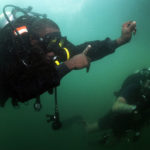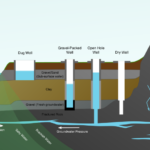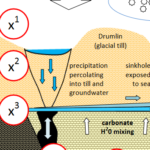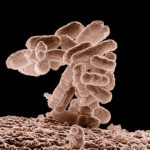 From Science Daily comes a neat article (apropos!): “Mexico’s Yucatan Peninsula reveals a cryptic methane-fueled ecosystem in flooded caves“.
From Science Daily comes a neat article (apropos!): “Mexico’s Yucatan Peninsula reveals a cryptic methane-fueled ecosystem in flooded caves“.
Leading me back to a Mahone Bay side project, with queries sent to our caving club newsletter last spring. Investigating the Mahone Bay “colonial limestone trade” hypothesis has taken me on a wide-ranging investigation. The Bay’s archipelago includes drumlin islands that cover submerged karst hillocks and a marine till plain. 10 islands have ponds in depressions. I’ve been thinking the ponds ought to be investigated. Are the ponds cenotes linked to the sea as submerged till-filled passage or as seeps? Could they harbour self-contained ecosystems?
 Thus far, have not found reference to significant changes in pond surface height, so presumably if there is passage through till at the base of the pond, or percolation to a buried sinkhole, seeps or passage might be below low tide (Estimate spread: approximately 2 metres).
Thus far, have not found reference to significant changes in pond surface height, so presumably if there is passage through till at the base of the pond, or percolation to a buried sinkhole, seeps or passage might be below low tide (Estimate spread: approximately 2 metres).
Experiment #1 : The Limestone Trade History project (See elsewhere At this site)
Experiment #2 concept (April 2017): Estimating Tide-induced Changes in Drumlin Pond Surface Height
 : Do changes in pond surface elevation indicate tidal influx denoting the presence of a cenote or pressurizing of groundwater? Can the waveform be used to assess survivability of unique bacteriological lifeforms?
: Do changes in pond surface elevation indicate tidal influx denoting the presence of a cenote or pressurizing of groundwater? Can the waveform be used to assess survivability of unique bacteriological lifeforms?
Pond height changes (10 island candidates)
- flow meter in pond vs. seaside
- lake gauge in pond vs. seaside – automatic datalogger of tide cycle effects
- GPS surface monitoring (local altimeters linked to GPS)
- Lidar and other em-band overflights by drone, tasked to fly specific repeat paths
Experiment #3 concept (April 2017): Sampling Sealed Submerged Chambers Using Island Boreholes
 Borehole, in-situ, opened and sampled to test for engagement in chemosynthesis.
Borehole, in-situ, opened and sampled to test for engagement in chemosynthesis.
Oak Island’s borehole could be a source of samples, as there is evidence of karst cavities below the water table. Unfortunately, the original boring was not for scientific study, thus new samples may not be rated “pristine”, but might be rated pristine relative to when last sealed. Borehole sampling ought to be through a sealed chamber to protect against further contamination, and data could be compared to samples obtained at the other sites. Would these conditions, parallel to the Mexico study, emulate submerged/subterranean conditions proposed for Europa (moon of Jupiter) and Enceladus (moon of Saturn)?.
Extremeophile sampling tools (candidate sites assumed to reduce in number from Experiment #2)
Phase 1
- Water column studies in extant borehole or new boreholes
- biochemical/geo-sampling tool lowered through sealed borehole
- Satellite analysis of overlying glacial till to evaluate subsurface influence
Phase 2
- Side-scan bathymetry along designated paths near karst feature outfalls
- Diving along fault path where there is a bedding plane
- Diving to suspected submerged sinkholes 15-30 metres below datum sea level
- Comparison of biota and fauna to nearby sea life
- Fluorescein dye test if passage exits cannot be located by divers
Images:
Canadian navy diver helps Jamaican Coast Guard diver practice his mobility in a dry-suit diving suit during multinational exercise, By Official Navy Page from United States of America MC1 Jayme Pastoric/U.S. Navy [Public domain], via Wikimedia Commons, https://commons.wikimedia.org/wiki/File%3AFlickr_-_Official_U.S._Navy_Imagery_-_Canadian_navy_diver_helps_Jamaican_Coast_Guard_diver_practice_his_mobility_in_a_dry-suit_diving_suit_during_multinational_exercise.jpg
Concept sketch, D.Huer.
Low-temperature electron micrograph of a cluster of E. coli bacteria, magnified 10,000 times. Each individual bacterium is oblong shaped., By Photo by Eric Erbe, digital colorization by Christopher Pooley, both of USDA, ARS, EMU. [Public domain], via Wikimedia Commons: https://commons.wikimedia.org/wiki/File:E_coli_at_10000x,_original.jpg
Water Well Types Wiki, By Confuciou (Own work) [CC BY 3.0 (http://creativecommons.org/licenses/by/3.0)], via Wikimedia Commons https://commons.wikimedia.org/wiki/File%3AWater_well_types_wiki.svg